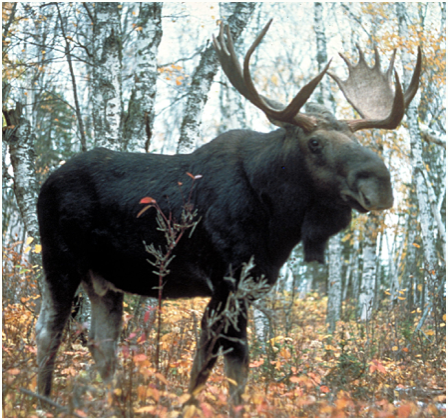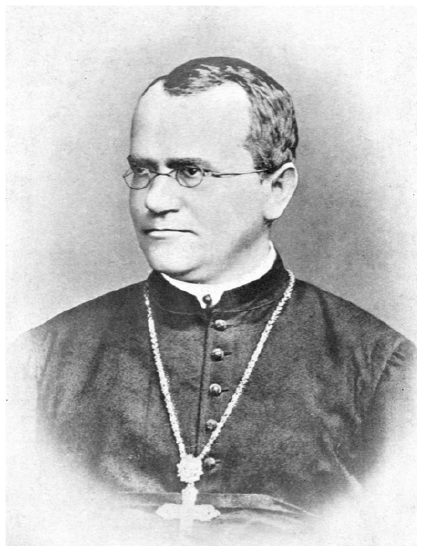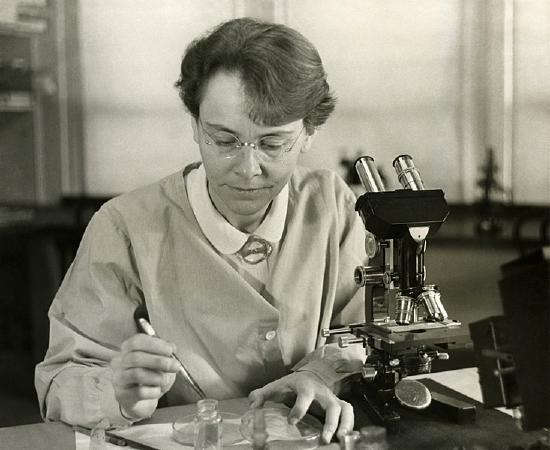1.6: The Nature of Science
- Last updated
- Save as PDF
- Page ID
- 30599
Why Does a Moose Have Antlers?
Did you ever wonder why a moose, like the one in Figure \(\PageIndex{1}\), grows large antlers? The antlers may grow as wide as 1.8 m (6 ft) from tip to tip! The antlers use up a lot of energy to grow and carry around. They can even get caught in brush and trees. In these ways, they would seem to be more of a detriment than a help, so what purpose do the antlers serve? And why do only male moose grow them? If you've ever asked questions such as these about the natural world, then you were thinking like a scientist.

Defining Science
Science is a distinctive way of gaining knowledge about the natural world that starts with a question and then tries to answer the question with evidence and logic. Science is an exciting exploration of all the whys and hows that any curious person might have about the world. You can be part of that exploration. Besides your curiosity, all you need is a basic understanding of how scientists think and how science is done. In this section, you'll learn how to think like a scientist.
Thinking Like a Scientist
Thinking like a scientist rests on certain underlying assumptions. Scientists assume that:
- Nature can be understood through systematic study.
- Scientific ideas are open to revision.
- Sound scientific ideas withstand the test of time.
- Science cannot provide answers to all questions.
Nature is Understandable
Scientists think of nature as a single system controlled by natural laws. By discovering natural laws, scientists strive to increase their understanding of the natural world. Laws of nature are expressed as scientific laws. A scientific law is a statement that describes what always happens under certain conditions in nature.
Examples of scientific laws include Mendel's Laws of Inheritance. These laws were discovered by an Austrian Monk, named Gregor Mendel (Figure \(\PageIndex{2}\)), in the mid-1800s. The laws describe how certain traits are inherited from parents by their offspring. Although Mendel discovered his laws of inheritance by experimenting with pea plants, we now know that the laws apply to many other organisms, including human beings. The laws describe how we inherit relatively simple genetic traits, such as blood type, from our parents. For example, if you know the blood types of your parents, you can use Mendel's laws to predict your chances of having a particular blood type.
Barbara McClintock (Figure \(\PageIndex{2}\)) added to our understanding of inheritance in the 1950s by discovering how chromosomes exchange information during meiosis. Meiosis is how organisms produce reproductive cells (such as egg or sperm). McClintock worked with corn and, using the color traits in the kernels demonstrated how crossing-over is used to exchange information between chromosomes. An understanding of how crossing-over works is essential to our understanding of inheritance because it explains why using Mendelian rules of inheritance does not always produce the correct ratios.


Scientific Ideas are Open to Change
Science is more of a process than a set body of knowledge. Scientists are always testing and revising their ideas, and as new observations are made, existing ideas may be challenged. Ideas may be replaced with new ideas that better fit the facts, but more often existing ideas are simply revised. For example, when scientists discovered how genes control genetic traits, they didn't throw out Mendel's laws of inheritance. The new discoveries helped to explain why Mendel's laws applied to certain traits but not others. They showed that Mendel's laws are part of a bigger picture. Through many new discoveries over time, scientists gradually build an increasingly accurate and detailed understanding of the natural world.
Occasionally, scientific ideas change radically. Radical changes in scientific ideas were given the name paradigm shifts by the philosopher Thomas Kuhn in 1962. Kuhn agreed that scientific knowledge typically accumulates gradually, as new details are added to established theories. However, Kuhn also argued that from time to time, a scientific revolution occurs in which current theories are abandoned and completely new ideas take their place.
Although there is debate among scientists as to what constitutes a paradigm shift, the theory of evolution is widely accepted as a good example in biology. In fact, some scientists argue that it is the only example of a paradigm shift in biology. Prior to Charles Darwin's publication of his theory of evolution in the 1860s, most scientists believed that God had created living species and that the species on Earth had not changed since they were created. Drawing on a great deal of evidence and logical arguments, Darwin demonstrated that species could change and that new species could arise from pre-existing ones. This was such a radical change in scientific thinking that Darwin was reluctant to publish his ideas for fear of a backlash from other scientists and the public. Indeed, Darwin was at first ridiculed for his evolutionary theory, but in time, it was widely accepted and became a cornerstone of all life sciences.
Scientific Knowledge May Be Long Lasting
Many scientific ideas have withstood the test of time. For example, about 200 years ago, the scientist John Dalton proposed atomic theory — the theory that all matter is made of tiny particles called atoms. This theory is still valid today. During the two centuries since the theory was first proposed, a great deal more has been learned about atoms and the even smaller particles of which they are composed. Nonetheless, the idea that all matter consists of atoms remains valid. There are many other examples of basic scientific ideas that have been tested repeatedly and found to be sound. You will learn about many of them as you study human biology.
Not All Questions Can be Answered by Science
Science rests on evidence and logic, and evidence comes from observations. Therefore, science deals only with things that can be observed. An observation is anything that is detected through human senses or with instruments and measuring devices that extend human senses. Things that cannot be observed or measured by current means — such as supernatural beings or events — are outside the bounds of science. Consider these two questions about life on Earth:
- Did life on Earth evolve over time?
- Was life on Earth created by a supernatural deity?
The first question can be answered by science on the basis of scientific evidence such as fossils and logical arguments. The second question could be a matter of belief but no evidence can be gathered to support or refute it. Therefore, it is outside the realm of science.
Feature: Human Biology in the News
Scientific research is often reported in the popular media. In fact, that's how most people learn about new scientific findings. Informing the public about scientific research is a valuable media service, but the types of scientific investigations that are reported may lead to a distorted public perception of what science is and how reliable its results are. Why? There are actually two types of science, often referred to as consensus science and frontier science. The latter type of science is the type that usually makes the news, but the media generally do not distinguish between the two types. Therefore, many people may infer that what they read about frontier science is typical of all science.
- Consensus science refers to scientific ideas that have been researched for a long period of time and for which a great deal of evidence has accumulated. This type of research generally fits well within current scientific paradigms. A good example of consensus science is global climate change. Data showing the impact of increasing levels of atmospheric carbon dioxide, due to human activities, on global warming have been accumulating for many decades. Today, virtually all climate scientists agree that global warming is occurring and that human actions are largely responsible for it. However, the few scientists — and many politicians — who do not agree with the consensus view receive greater media attention because the consensus view is "old" news. The findings have been coming in for years, and new research in the area keeps finding similar results.
- Frontier science, in contrast, refers to scientific ideas that are relatively new and have not yet been supported by years of scientific evidence. Frontier research takes place at the frontiers of knowledge in a particular field. A good example of frontier science is research into the presumed link between cholesterol in the diet and cholesterol in the blood. The consensus view for many years was that a diet high in cholesterol increases blood levels of cholesterol, which may lead, in turn, to cardiovascular disease. Recent research challenging this accepted view found that genes play a more significant role than diet in blood levels of cholesterol and risk of cardiovascular disease.
The media tend to focus on frontier science because it seems controversial and may lead to major new scientific breakthroughs. With more research, ideas in frontier science may be supported by more evidence, gain wider acceptance, and become consensus science. In some cases, frontier science that is at odds with a current paradigm may even lead to a paradigm shift. However, the opposite may happen instead. Additional research may undermine the initial findings of frontier research so that the new and exciting ideas are rejected. Unfortunately, when frontier science is later shown to be mistaken, people may infer that all science, including consensus science, is unreliable.
Review
- Define science.
- What is the general goal of science?
- Identify four basic assumptions that scientists make when they study the natural world.
- Explain why science cannot provide answers to all questions.
- Do observations in science have to be made by the naked eye? Can you think of a way in which scientists might be able to make observations about something they cannot directly see?
- If something cannot be observed, can it be tested scientifically?
- What do you think would be more susceptible to being disproved — conclusions drawn from frontier science or consensus science? Explain your reasoning.
- Scientific knowledge builds upon itself. Give an example of a scientific idea from the reading where the initial idea became extended as science advanced.
- What is a dramatic change in scientific understanding is called?
- Discuss this statement: “Scientific ideas are always changing, so they can't be trusted.” Do you think this is true?
- True or False: Science is a process.
- True or False: A scientific law describes what happens most of the time under certain conditions.
- What is one piece of evidence that life on Earth evolved over time?
- Why do you think that as technology advances, scientific knowledge expands?
Explore More
Attributions
- Moose Superior by USDA Forest Service, public domain via Wikimedia Commons
- Gregor Mendel by Hugo Iltis via the Wellcome Library, London, public domain via Wikimedia Commons
- Barbara McClintock by mithsonian Institution/Science Service; Restored by Adam Cuerden, public domain via Wikimedia Commons
- Text adapted from Human Biology by CK-12 licensed CC BY-NC 3.0


